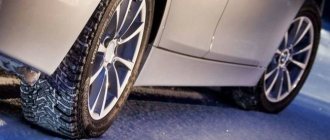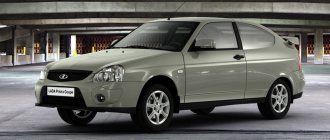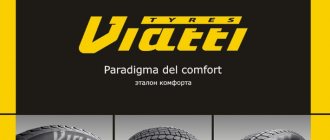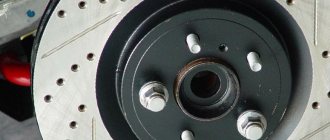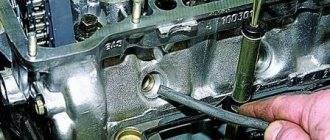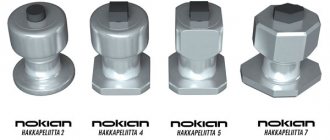We select a company
The most affordable is Cordiant Snow Cross.
A completely domestic (both development and production) tire, modernized last year. Another model from last season is a little more expensive - Dunlop SP Winter Ice 02. Four more tires that can be called inexpensive by today's standards are Nitto Therma Spike (the second brand of the Japanese company Toyo), South Korean Kumho WinterCraft Ice, and the popular Formula Ice (developed by Pirelli , and the production is Russian) and the “Japanese” Malaysian “assembly” Toyo Observe G3‑Ice, popular on the market.
Among the representatives of the second echelon are new models with German and Finnish ancestry, but produced in Russia: Gislaved Nord Frost 200 with a tread copied from the first generation ContiIceContact, and Nordman 7 with the “face” of the Hakkapeliitta 7 tire.
And finally, the leaders of our past tests: Goodyear UltraGrip Ice Arctic and Continental IceContact 2. And also a hot new product from Nokian - the Nokian Hakkapeliitta 9 model.
Which winter tires are best to choose in the end?
So which winter tires are best? The 2020 rating includes both “urban” types of tires and tires designed for more severe weather conditions. For frequent off-road driving, Pirelli Ice Zero, Continental IceContact 2 or Dunlop SP Winter ICE 02 are perfect. For quiet city driving, it is better to choose Bridgestone Ice Cruiser 7000, Nokian Nordman 5 or Nokian Hakkapeliitta 8. Otherwise, when choosing tires, you should first consider temperature conditions, and the surface on which you will have to drive.
For the next stud test, Za Rulem experts collected six sets of 15-inch tires from Western and Eastern manufacturers. Some have experience and the latest technologies among their trump cards, while others have the will to win and affordable prices. And each tire has its own pros and cons.
This time we chose one of the most popular sizes - 195/65 R15, which suits many small and inexpensive cars. Different markets, different understanding of the product, different design schools. What distinguishes tires from the East and West from each other, what are their strengths and weaknesses, and what should the Russian buyer pay attention to?
Tires in the north
We have already conducted tests outside of Russia and consider this experience to be very positive. This time we decided to go to the Pirelli winter training ground. It is located in the northern part of Sweden, in the province of Norrbotten, near the town of Älvsbyn. Ice trails are laid on the frozen lake Lilkorstresk (Small Cross Swamp), and snow trails along its shores.
At the beginning of February, pre-run-in tires were delivered there, and at the end of the month we carried out all the snow and ice tests. The temperature during the tests ranged from -1 to -15 ºС, but at first the Swedish north made me very nervous. On the first day of our work, a warm atmospheric front came to the shores of the Gulf of Bothnia - and the air temperature rose to plus seven degrees! Snow and ice melted before our eyes. Locals said that in their entire lives they could not remember such warmth in February. Only on the third day, in the evening, it froze, the melted lake ice became stronger again and within a day it was already holding the car. Let's start testing on ice!
We saddle up the brand new Kia Rio hatchback and refine our own “toolkit”. This time, in all exercises, experts give assessments not in whole points, but in half-point increments - for greater accuracy of the results.
Which auto industry products should I choose?
When comparing the products of Kordiant JSC and Nokian Tires, one should not forget that their “fighters” are located in different price categories , and in each segment the former usually lose to the latter in terms of price and characteristics.
Recommendations for winter “footwear”:
- For “hunters” of premium goods, tires from a Finnish manufacturer will be an excellent choice. It is better to ride in any weather conditions on Hakkapeliitta 9 , costing from 4110 rubles .
- Fans of “toothless slippers” would prefer to opt for the Nordman version 7 , which is ahead of its premium “relative” in the competition on snow and ice and is the leader in terms of modest appetite. But on asphalt you will have to move slower. Cost from 2670 rub .
- For provincials, for whom it is important not to “fly away” on the highway and get out of a snowdrift, the Snow Cross 2 brand costs from 2,225 rubles .
- Tunga Nordway 2 can be purchased only if there is nothing else (priced from RUB 2,023 ). It would be advisable to use only at a “snail” speed on hard surfaces cleared of snow and ice. Driving on such tires is painful for experienced drivers and dangerous for beginners.
Recommendations for summer tires:
- Hakka Green 2 will provide the buyer with reliable handling and grip with high efficiency. Cost from 2323 rub . Experts estimate the actual price to be too high. The buyer overpays for the brand and for the excellent quality of all product properties confirmed by tests.
- Nordman SX2 is suitable for “riders” who do not strive to become winners at any cost, but want to get good handling at a reasonable speed and a price starting from 2010 rubles . The model is considered an excellent performer in its segment in terms of consumer characteristics.
- Comfort 2 is preferable for relaxed riders in inexpensive cars. It has advantages over its rivals on city roads in terms of performance and softness. It is characterized by low efficiency at 90 km/h, but difficult controllability when implementing extreme maneuvers. Cost from 2000 rub .
On thin ice
The Rio showed the best acceleration, 6.5 seconds, on Continental tires, the second result was on Nokian: 6.8 seconds. No one doubted that tires with 185–186 studs would be ahead. However, Cordiant, Goodyear and Nordman, which each have 110 studs, are hot on their heels - these three show a result of 6.9 seconds. The longest acceleration is from Kumho: 9.7 seconds.
In braking, Nokian wins over the Continental by the slightest - 16.4 meters versus sixteen and a half, and the third result, 16.7 meters, is shown by Goodyear. Kumho was again the last: 23.7 meters.
Which tires do car owners choose - Pirelli or Nokian Tyres?
In September 2020, according to PartReview, Nokian Tires tires topped more car ratings than Pirelli:
Nokian Tires is chosen by owners of such cars as: BMW 1er, Honda CR-V, Kia Spectra, Peugeot 307, BMW X1, Ford Fiesta, Ford Mondeo, Ford Transit, Hyundai Accent, Hyundai ix35, Hyundai Tucson, Mitsubishi Pajero Sport, Nissan Almera, Nissan Almera Classic, Renault Fluence, and others.
Pirelli is chosen by owners of such cars as: Audi 100, Daewoo Nexia, Ford Focus, and others.
Pit at zero
We evaluate controllability on a closed circuit configuration. This is a “track” about a kilometer long with turns of different radii and a long straight. And most importantly, the ice here is very slippery, polished by the wind. We carry out the assessment together, we drive three laps each on each set of tires, then we change.
Crap! Incredibly slippery! To change places, I had to literally crawl from one side to the other without taking my hands off the car.
Nokian tires earned the highest score in this exercise: clear reactions and good steering information are complemented by a soft, predictable start to the car's slip and stable grip regardless of the degree of slippage.
The Rio, shod with Nordman and Nitto tires, performed slightly worse. In the first case, I liked the good balance of longitudinal and lateral grip, the clear moment of transition to sliding. The rating was slightly reduced due to slight delays in reactions. At Nitto, the car captivated us with its good handling even when sliding and its tight, “understandable” steering at large turning angles. However, there were minor complaints about the information content of the steering wheel at small angles - in the initial phase of turning. The tire industry calls this effect hole in zero.
The lowest scores were given to Gislaved, Goodyear and Formula. On these tires, the driver is forced to increase the steering angles, causing delays in reactions. In addition, Rio on Gislaved tires slides for a long time in a turn, and then the grip is sharply restored, which provokes a whip effect - a sharp skid in the opposite direction.
Goodyear did not like the imbalance of longitudinal and lateral grip: the car holds the turning arc much worse than it accelerates and brakes. On Formula tires, there is low steering input when cornering, which provokes twisting and subsequent skidding.
The ice circle is the most unpleasant exercise for the driver. You need to find the maximum speed on the verge of sliding, show the best time (it is recorded by VBOX) and confirm it. In this case, you have to drive in one direction, counterclockwise. With good grip, the body and head roll with a decent lateral force - you constantly strain all your muscles. You have to constantly look from the “road” to the instruments and back. After about fifty laps my head starts to spin.
The Continental and Nokian turned out to be faster than the others on the lap - 19.9 seconds per full revolution. Cordiant was just one tenth behind them (20.0 sec). The slowest tires are Kumho: the best achievement is 22.5 seconds.
How many laps did you have to do on each set to achieve the best results and repeat them? From ten to fifteen! The only tires that required more attention and skill were Goodyear: the car shod with them kept trying to skid, and I had to do 19 laps. And in total, taking into account repeated races on base tires, our Rio had to turn up more than two hundred revolutions!
The best Pirelli models
The range of Pirelli car tires is full of worthy models that can be considered one of the best European modifications from the Italian manufacturer. Specialists in the field of tire design especially note models such as the Cinturato P4 and Ice Zero. Why did experts like these particular models?
Ice Zero is the best car tire for winter use from Pirelli. And this is no coincidence, since these tires have very highly developed functionality. Pirelli is one of the few companies that is not switching to mass production of studless winter tires. The point is not that the specialists of this company do not trust their own rubber alloy and doubt its quality.
First of all, Italians think about how to ensure the maximum level of safety for drivers when driving. Therefore, this model not only has tires with high reliability indicators, but is also additionally equipped with studs, so that the degree of safety for using these tires is even higher.
These tires are not only studded, but also additionally siped, which provides excellent grip on the road surface. Drivers who use these tires on their cars can be 100% confident about their own safety!
The Cinturato P4 is also Pirelli's best summer tire. This is easily explained by the fact that these tires have a large number of qualities and properties, the development of which creates a comfortable driving environment, maximum controllability and maneuverability, as well as excellent grip.
Let's move on to snow procedures
Snow fell exactly the next day after all ice tests were completed. It is easier to prepare a track for assessing handling than a plateau for measuring longitudinal grip. Therefore, we start with more creative and interesting work.
At one bend the route lies on the side of a hill, so it has a short but rather steep ascent and descent. This is a “trick” of local tracks for assessing handling - most tire manufacturers use mainly flat tracks. Ascents and descents load and unload the suspension, changing the vertical forces acting on the wheels. It is especially interesting when the wheel is unloaded in a turn: the downforce decreases and the tire begins to slip.
Fresh snow fell on the cold ice and shifted as the car slid around the turns. The result was a mixed surface: sometimes snow, sometimes ice - a real Russian road!
Here, in terms of handling, I liked the Nokian tires more than others: very soft but confident cat-like habits, predictable behavior of the car. Rio on these tires does not require special skills or techniques from the driver - he simply turns. The maximum speed is limited by a soft skid that helps to register the turn, requiring virtually no adjustment.
The experts made the greatest claims against the next three participants. Cordiant is annoying with an unexpectedly occurring skid with a sharp, unpredictable stall, a long slide and the same sharp restoration of traction, which provokes a “shooting” skid in the opposite direction. On Gislaved tires, the steering wheel becomes unpleasantly empty and uninformative - you have to turn it at excessively large angles, which leads to an unexpected sharp slip into a skid and deep slides. I didn’t like the Kumho tires because of noticeable delays in reactions, significant steering angles, prolonged slides and deep skidding on an arc, requiring immediate adjustments from the driver.
The “rearrangement” exercise was only partially completed due to excessively soft snow - they were able to evaluate only the behavior of the vehicle during extreme maneuvering, and refused to determine the maximum speed for successfully completing the maneuver.
Here, as on the handling track, Nokian tires earned the most points thanks to the clearest reactions, soft and predictable behavior and easy self-correcting drift at top speed. I liked Dunlop least of all: on these tires the Rio exhibits not only noticeable delays in reactions, but also an unstable, wide balance of turning: from significant drift of the front axle at the first tug of the steering wheel to skidding of the rear wheels when trying to stabilize the car in a lane change.
And here is a well-trodden snowy straight line - you can start measuring acceleration time and braking distance. As in similar ice exercises, we combine acceleration with braking, repeating the exercises eight to ten times. Moreover, the acceleration time from 0 to 40 km/h on snow was assessed twice - with the TCS traction control system turned on and without it. Braking from 40 to 5 km/h - only with ABS.
So, acceleration is normal, with TCS preventing tire slippage. The best results are on Continental, Goodyear and Nokian tires. On them, the Rio reaches 40 km/h in exactly six seconds. Kumho has the worst performance. Just like on ice, they accelerate slowly, trailing the leaders by more than 11%.
We turn off the electronic “collar” and repeat the measurements. It turns out faster! Goodyear holds the leading position: 40 km/h from a standstill is achieved in 5.2 seconds. Acceleration on Continental and Nokian tires lasts only one tenth longer. Kumho tires also show the most modest results in this mode.
Braking is won by the leading pair - Continental and Nokian, which showed the same result: 14.8 meters. The last ones this time are relatives Nitto and Toyo.
The final exercises are to evaluate directional stability on a snowy road and cross-country ability in deep snow. At high speed, the Rio, shod with Nokian, follows a given course better than others and is most clearly rebuilt. Additionally, we note the high information content of the steering: the driver drives the car in a straight line intuitively, without concentrating.
Four participants had the worst scores. On Cordiant and Gislaved tires, when changing lanes, the Rio experiences unpleasant steering of the rear axle, which turns into a skid. An attempt to correct the course on Dunlop and Kumho tires is fraught with skidding, requiring immediate action even with soft lane changes.
Goodyear tires are more confident than others in deep snow - with them the Rio is ready to conquer any snowdrift. But on Kumho and Toyo tires you can only drive well. Getting underway in the snow is extremely difficult: the slightest slip and the wheels slip, digging deeper and deeper.
Dirty work
The first to go into action is the black Golf, which has both an anti-lock braking system and traction control. We start with accelerating and braking on ice on a small frozen lake, repeating the runs eight to ten times for each set of tires. After two or three test sets, measurements are taken on base (reference, as tire manufacturers say) tires: you can’t do without them.
Measurements on different surfaces differ in the “upper” speed limit, which serves as the maximum speed value during acceleration and the initial speed value during braking. On ice this value is 20 km/h, and on snow - 40 km/h, since a modest ice surface is much smaller than a snowy one. Having recalculated the results taking into account the corrections determined using reference tires, we get the leaders and outsiders in these exercises.
The real surprise came from Hankook, which tore apart the traditional leaders. Incredibly, on these tires the Golf accelerates and brakes on ice even better than on the Continental and Nokian. To accelerate from zero to 20 km/h, the Golf on Hankook tires needed only 4.1 seconds, and the braking distance from 20 to 5 km/h was 6.6 meters. The longest acceleration was achieved on Gislaved tires: 5.9 seconds. A close result, 5.8 seconds, was obtained on the GT Radial and Firestone tires. The Golf slowed down worst on the GT Radial tires: the braking distance was 8.7 meters.
The fastest acceleration on snow to 40 km/h was provided by Continental tires with an indicator of 5.9 seconds, and Hankook was only one tenth behind them! The slowest tires are the GT Radial tires.
When braking on snow, Hankook took the lead. To slow the Golf from 40 to 5 km/h, these tires needed 16.9 meters. Second place goes to Gislaved: 17.2 meters. The Firestone and GT Radial were last in braking: 19.1 and 19.0 meters, respectively.
We complete the series of tests on ice by measuring the lap time, which characterizes lateral grip. The Continental maintained its lead, completing the lap in a record 15.6 seconds. The closest competitors - and these are Hankook, Nokian and Gislaved - needed half a second more. The car completed the slowest lap, in 18.0 seconds, on Bridgestone tires.
What's with the spikes?
We were pleasantly surprised. On all tires after running in, the studs protruded above the tread within reasonable limits. The maximum is 1.41 mm for Cordiant, the minimum is less than 0.9 mm for Formula, Gislaved and Nokian tires. But the Nokian has 185 studs on each tire, while the Formula and Gislaveda have only 110. And such a number with such a small protrusion is clearly not enough to provide good grip on ice.
Let us remind you that the regulated stud protrusion on new tires is no more than 1.2 mm. From experience we know that after running in this value can increase to 1.3–1.4 mm.
It is gratifying that tire manufacturers have stopped abusing the increased protrusion of the studs. After all, strongly protruding spikes “saw” the asphalt, which creates deep ruts. And for the first time during our tests, not a single tire lost a single stud, confirming the postulate that the reliability of stud retention in the rubber is inversely proportional to the amount of their protrusion. The less you stick out, the more you sit!
Winter tires R14 Pirelli reviews and prices
Tires Pirelli Ice Zero 185/60 R14 82T reviews
Find out the price Name:
Zheka47
Rating:
★★★★★
Advantages:
Braking properties, all-terrain ability, grip
Disadvantages:
In my opinion, there are none
Comment:
I am quite satisfied with the purchase of tires, they behave with dignity both in the city and outside it.
Rubber is characterized by an instant braking response on dry and wet asphalt, icy surfaces, slush, and compacted snow. When moving, the tires make a slight noise, but this is typical for all studs and is not at all annoying Name:
Tem Temych
Rating:
★★★★★
Advantages:
Durability of the studs, high quality projector, durability, reliability, stability in any weather and temperature
Disadvantages:
no jambs
Comment:
These tires glide wonderfully in the snow and hold up well on any icy surface (even wet ones), due to the high-quality and reliable studs.
The behavior of the rubber is predictable in any weather and temperature, the wear resistance is high (in a couple of seasons not a single stud has been lost and the projector is still normal). I am very pleased with the purchase and recommend it to everyone, you won’t regret it. Name:
Pontius Pilate
Rating:
★★★★★
Advantages:
Excellent acceleration, predictable handling on ice and loose snow, grip, braking, stud strength, durability, wear resistance
Disadvantages:
None found during use
Comment:
These are the best studs I have ever I had a chance to use it. The tires handle flawlessly in icy conditions and snow slush; the car does not skid when turning or overtaking. The rubber literally bites into the ice when braking, and also accelerates the vehicle well on slippery surfaces. The spikes sit firmly, not a single one was lost during the winter period. The cost is high, but high-quality tires cannot be cheap.,
Tires Pirelli Formula Ice 185/65 R14 86T reviews
Find out price Name:
Anna
Rating:
★★★★★
Pros:
Excellent tires.
Name:
Oksana
Rating:
★★★★★
Advantages:
Almost no noise, soft, excellent maneuverability, good price and fast delivery, tread.
Disadvantages:
None
Comment:
It's time to choose winter tires. It took a very long time to choose, since the last one (Nokian) didn’t last even 2 seasons: almost all the thorns fell out, it made a lot of noise and 2 hernias came out. We chose this manufacturer on the advice of friends and have not regretted it yet: the tires are soft, almost inaudible, and provide excellent braking. We'll see at the end of the season how the spikes feel. Overall, I really liked the tires, especially considering the fact that winter has not yet settled in: in some places there are puddles, and in others there is ice—the grip on the asphalt is excellent. I especially want to note that the tires arrived fresh (2018).
Tires Pirelli Ice Zero 175/65 R14 82T reviews
Find out price Name:
Anton12.91
Rating:
★★★★★
Advantages:
Good grip on ice, compacted and loose snow, the price tag is quite optimal, reliable, soft
Disadvantages:
No defects at all
Comment:
Excellent grip on the road in all situations. This tire is quite worthy of attention. After installation, the ride became more comfortable and safe. It rides great on dry and wet asphalt. Perfectly suited for the city. The price is quite adequate, not overpriced. I can say that the appearance of the rubber has been well preserved after a season of use. Suitable for driving in severe frosts. I didn't notice any noise when driving the car. I recommend this model for purchase.
Tires Pirelli Winter Ice Zero 175/70 R14 84T 2508100 studded reviews
Find out price Name:
Violetta
Rating:
★★★★★
Advantages:
the cheapest price
Comment:
I needed to buy one additional wheel, only on this site I could find the sale of one wheel, not a set, everything was delivered quickly and for free, very convenient,
Tires Pirelli Ice Zero 185/65 R14 86T reviews
Find out price Name:
Vitalya007
Rating:
★★★★
Advantages:
softness, tenacity, durable spikes.
Disadvantages:
A bit noisy.
Comment:
I was pleased with these tires, I drove them through the winter and the studs remained in place.
They are quite soft, easy to control, go well on ice even uphill, and are very grippy. Name:
Emelyanov35
Rating:
★★★★★
Advantages:
Durability, grip, goes confidently on slippery roads.
Disadvantages:
None found.
Comment:
I've ridden these tires for almost two seasons now, and they're almost like new. I liked that it has a double spike so the grip on the surface is excellent. It goes well on both ice and loose snow. The car doesn’t drift when turning, and braking on ice didn’t let me down either.
Tires Pirelli Ice Zero 185/70 R14 88T reviews
Find out price Name:
Igor
Rating:
★★★★★
Advantages:
Quality, durability
Disadvantages:
a little noisy.
Comment:
The best option value for money.
Name:
Nikifor
Rating:
★★★★★
Advantages:
Everything is good
Disadvantages:
There are no jambs
Comment:
The tires are predictable in handling, durable and resistant to low temperatures, snow and ice.
Ideal value for money. Name:
Alabai
Rating:
★★★★★
Advantages:
Quality, reliability, lack of noise, softness
Disadvantages:
None
Comment:
The tires are soft, not particularly noisy, and hold up well on the road in any weather.
The wear of the rubber is minimal over the period of use (2 seasons) and a scarlet number of studs have fallen out. Name:
Igorek01
Rating:
★★★★
Advantages:
high-quality and durable tires
Disadvantages:
noisiness
Comment:
This tire model has the perfect combination of price and quality.
I drove it all winter and have no complaints, the condition is perfect, there is no question of buying new shoes. True, the tires make too much noise, especially when driving on dry asphalt. Name:
Kapitoshka
Rating:
★★★★★
Advantages:
Safe driving, durable studs, high quality, reliability
Disadvantages:
During the period of operation, I did not find any cons
Comment:
With the purchase of this tire model, I continue to fearlessly drive my car even in the most inclement weather.
The tires have excellent grip, durable studs and are characterized by stability on ice, wet asphalt and slush. Name:
Olya Dunaeva
Rating:
★★★★★
Advantages:
Wear resistance, quality, quick response
Disadvantages:
Zero
Comment:
I purchased tires last year and I have extremely positive impressions of them. In any weather and precipitation, the car is predictable in handling, the braking distance is minimal even on ice. During the period of use, all the studs remained in place, I think the rubber will still serve me for a couple of seasons. You won't find anything better in this price segment.
Tires Pirelli Formula Ice 175/65 R14 82T reviews
Find out price Name:
Nesterov
Rating:
★★★★★
Advantages:
I ordered these tires in Dizilband, the store turned out to be good, the tires arrived fresh from 2020, the quality of the rubber is high, excellent grip on ice and snow, made in Russia, not noisy, soft and comfortable.
Disadvantages:
none
Comment:
The price is a little high, but the tires are excellent.
Name:
Ernest
Rating:
★★★★★
Advantages:
I bought these tires on a Lada Vesta, the advantages I liked were the cross-country ability, good grip on ice, many studs, tires were manufactured in 2020, made in Russia.
Disadvantages:
no complaints, I'm satisfied.
Comment:
Excellent tires.
Name:
Askold
Rating:
★★★★★
Advantages:
I bought Pirelli Formula Ice tires on Lada Granta, on the plus side, fresh tires from 2020 arrived, a very good price of 2000 rubles per wheel, well packaged, delivered quickly, I’m satisfied.
Disadvantages:
none
Comment:
Excellent tires.
On the asphalt
In Tolyatti, at the AVTOVAZ training ground, we again had to wait for the weather. Dry roads and calm conditions are the conditions for obtaining reliable results on rolling resistance. The asphalt part of the tests could only be completed in the first half of May. We had to work at night to meet the permissible temperature for winter tires +5…+7 ºC.
The procedure for assessing efficiency is the same as in the case of summer tires. We start by warming them up, making a full circle around the speed ring (10 km) at a speed of 110–120 km/h. At the same time, we evaluate how much the car deviates from a given course under the influence of external forces (side wind, slope), and also maneuver smoothly, simulating a gentle detour around an obstacle or changing lanes for overtaking. At the same time, the tester carefully monitors the reactions and behavior of the car, and also evaluates how convenient and understandable (read: safe) it is to drive. The wider the “zero” and the greater the angles of rotation of the steering wheel, to which the car does not respond, and the lower the information content (the rate of increase in force on the steering wheel with increasing angle of rotation), the worse the rating.
Experts gave Formula Ice tires the highest rating for directional stability: the clarity of course holding and reactions of the car wearing them can be the envy of some summer tires! The complete opposite is Dunlop tires. The main disadvantages in the behavior of a car on these tires: a wide “zero”, an empty steering wheel, delays in reactions when adjusting the course.
After a circle around the ring on a two-kilometer straight line, we estimate the amount of run-out from the maximum permitted “city” and “suburban” speeds. We take measurements in opposite directions and repeat three to five times, depending on the results obtained. At the same time, the driver accumulates impressions of the noise and smoothness of the ride at different speeds. Nokian tires turned out to be the greenest, that is, economical.
Before changing tires to refine its comfort rating, the Rio takes a lap around service roads with cracks and gouges. We found Gislaved, Toyo and Nitto tires to be the quietest, and Continental and Nokian to be the softest.
The next exercise is measuring braking distances on dry and wet surfaces. The initial braking speeds for winter tires are reduced by 20 km/h compared to summer tires - up to 80 km/h on dry roads and up to 60 km/h on wet roads. Continental tires looked better than others when braking on wet asphalt, and Nokian tires on dry asphalt. Nitto had the weakest results, regardless of the condition of the surface, and on dry asphalt, Nitto was joined by Cordiant.
Pirelli PZero
These tires are designed for cars with outstanding driving performance and a powerful engine. Available on the market in sizes from R16 to R22. The tire width ranges from 205 to 355 millimeters, the profile height ranges from 25 to 60. The maximum speed index is fixed at 300 kilometers per hour. Positioned as a premium product with an appropriate price.
pros
On dry asphalt, Pirelli PZero allows a lot and can even exceed the capabilities of the car on which such tires are installed. Stability in any speed range cannot be criticized - the course is clear and unshakable. The steering pleases with very sensitive reactions, high information content and predictability.
When cornering, outstanding lateral grip allows you to maintain high speed, while at the limit, in case of driver error, the car will smoothly straighten the trajectory, which is very safe. Braking performance is high on both dry and wet roads.
Minuses
PZeros are very uncomfortable. In particular, the noticeable hum and low smoothness of the ride when driving on roads with any type of surface are tiring. When driving in the rain and on very wet asphalt surfaces, there is a high risk of aquaplaning - the rise of the tire above the road is quite sharp and difficult to predict.
What do users think?
Owners are pleased with the high traction and good braking performance. But the reasons for dissatisfaction are the rapid wear of the tread and severe sensitivity to the ruts.
Summarizing
The winner of the test, scoring the most (936) points, was the new Nokian Hakkapeliitta 9
.
Second place with a total of 914 points went to the Continental IceContact 2
. We classify both tires as excellent and recommend them to drivers of all levels.
On the third step of our pedestal is Goodyear UltraGrip Ice Arctic
, which earned 898 total points, missing only two points from the title of excellent tires. His element is unclean winter roads and even virgin snow.
Nordman is in fourth position with 888 points
seventh generation. Very good tires for the Russian winter, they will give you confidence in any conditions.
All listed tires are located in our table of ranks in accordance with price ranking. Or they have a price that is adequate to the characteristics and properties, which, in fact, is the same thing. And starting from fifth place, slight distortions begin in one direction or another.
For example, Cordiant Snow Cross
earned 871 points, which allowed it to gain a foothold in the “very good tires” category and take fifth place in the final test result. They will not fail on any road, unless they require maintaining a long distance on dry asphalt due to modest grip properties, and also slow movement on a snowy road. You can buy them for 2500 rubles apiece.
Tires Dunlop SP Winter Ice 02
, which scored 852 points (sixth place), open the category of good tires. A decent product with average performance in almost all disciplines. Not without weaknesses, including modest lateral grip on ice, poor directional stability on snowy roads and asphalt, and a low level of comfort. But it sells for the same money as Cordiant Snow Cross: the price is 2,550 rubles.
On the seventh and eighth steps there are even more expensive tires - Toyo Observe G3‑Ice
and
Nitto Therma Spike
, practically brothers both “by blood” and by properties. They scored 847 points and settled in the “good tires” category. I liked the low noise level. The Toyo brand is well known in our market, but Nitto appeared quite recently, therefore it is a little cheaper.
Ninth and tenth places are shared by Gislaved Nord Frost 200
and
Formula Ice
, which earned 841 points each. These tires still fall into the good category. Gislaved, more even by objective indicators, “failed” in handling and directional stability in the snow. The Formula has somewhat unbalanced characteristics: it is weak in longitudinal grip on ice, but behaves more confidently on asphalt, is close to the best results in dry braking and provides clear course holding. But the difference in prices is noticeable: Formula is three hundred rubles cheaper, so a set of four pieces will save more than a thousand. However, there is one technical nuance that both tires have in common: the protrusion of the studs is insufficient - less than a millimeter after testing. We believe there was a glitch during the installation of the studs.
Seven or eight years ago, together with Continental, we studied the issue of stud protrusion and obtained the following pattern: one tenth of their protrusion is equivalent to three percent of the braking distance on ice. Increasing the protrusion of the studs to the legal limit of 1.2 mm on the new tires will allow Gislaved and Formula to improve longitudinal grip by about 10% - this is where the hidden reserves are hidden!
In eleventh place are Kumho WinterCraft Ice
, who scored 803 points. It’s a little weak for modern “spikes,” but it’s logical, since in most exercises these tires show modest results. Considering the not-so-low price, they can hardly be called a bargain.
Rubber "Gislaved" - manufacturer Sweden
A world-famous brand with a range of tires for cars for every taste and for any weather. Gislaved tires (manufactured in Sweden) enjoy great attention among owners of premium cars. The car tire manufacturing company was founded in 1893 in Jislaved. At first it produced various rubber products, then it began producing inner tubes for bicycles and cars. The first Swedish tires were produced in 1905. Having used Gislaved tires to equip Volvo cars, in 1927 the company increased production several times.
Tires for cars
The official manufacturer Gislaved has made significant achievements in the production of radial tires. In 1967, tires with steel cord were developed, and a high-tech plant for the production of these tires was opened. In 1992, the company became part of the German tire giant Continental AG, which made it possible to improve production using advanced modern technologies. The manufacturer takes a leading position in the development of new and improved tire designs for passenger cars, SUVs and vans.
Today, Gislaved wheels are created at car factories in different countries of the world that are part of the association of companies Continental AG.
In the manufacture of its products, the manufacturer Gislaved uses advanced technologies. The models have proprietary sipes that provide excellent grip on wet and snowy roads. This property was especially appreciated by residents of the northern regions. Branded tires are a huge success in countries with harsh climates. Buyers can choose any standard sizes and types of seasonal tires, the quality of which is controlled at all stages of production.
Additional Information!
Gislaved tires are tested in the toughest conditions in the northern region, ensuring the highest level of safety and excellent grip in all weather conditions.
A wide range of summer tires produced by , ensures safety, reliability and comfort in any road conditions.
You may be interested in this About mud tires UAZ Patriot
Production facilities of Continental AG
Count your money
In our chart, the tested tires are arranged from left to right in ascending order of price, with the height of the bars corresponding to the number of points scored. The small columns at the bottom of the chart display the relationship between quality and price and show how many points the tire gains for every thousand rubles paid for it.
If you put price at the forefront and scrupulously count every ruble, pay attention to another group of columns: the more points a tire earns for every thousand rubles of price, the more profitable the purchase! The rating is topped by Cordiant Snow Cross tires, and the test leader Hakkapeliitta 9 is in last place - expensive tires! Kumho WinterCraft Ice tires are in the middle range, which is why many people buy them.
By comparing all the results of our test and prices, you can make the right choice. Have a good trip!
Source www.zr.ru
“A specialist is like gumboil: his completeness is one-sided” Kozma Prutkov
——————- Spring has come quickly, it’s time to bother choosing summer tires - and I’ll still hesitate to give a review about winter ones))




